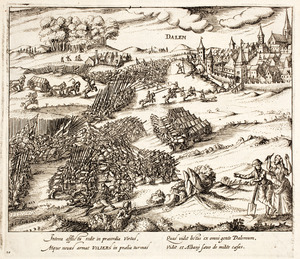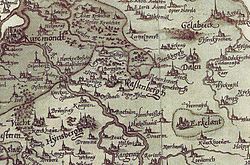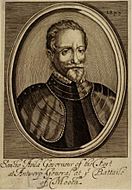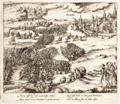Battle of Dahlen facts for kids
Quick facts for kids Battle of Dahlen |
|||||||
|---|---|---|---|---|---|---|---|
| Part of Eighty Years' War | |||||||
 The siege before Dalen, july 22 1568 (engraving) by Frans Hogenberg. |
|||||||
|
|||||||
| Belligerents | |||||||
| Dutch Rebels | |||||||
| Commanders and leaders | |||||||
| Jean de Montigny | Sancho d'Avila | ||||||
| Strength | |||||||
| 3,000 | 1,600 | ||||||
| Casualties and losses | |||||||
| ~2,000 killed | Very few | ||||||
The Battle of Dahlen happened on April 23, 1568. It was a fight between a Dutch rebel army and the Spanish army. The Dutch rebels were led by Jean de Montigny, also known as Lord of Villers. The Spanish army was commanded by Sancho Dávila y Daza.
This battle was part of William of Orange's plan to invade the Netherlands. The Dutch rebels were trying to capture the town of Roermond. But then the Spanish forces arrived, forcing the rebels to leave. Dávila chased the retreating rebels and defeated them near the small town of Dahlen (now called Rheindahlen). The rebels who survived ran to hide behind the walls of Dahlen. However, the Spanish soldiers finally defeated them there too. Some people consider this battle the official start of the Eighty Years' War.
Contents
Why the Battle Happened
In 1568, William I of Orange was a very important leader in the Netherlands. He and other noblemen were unhappy with Spain ruling their country. They wanted to get rid of Duke of Alba and his Spanish troops.
William, who was based in Germany, planned three attacks on the Netherlands.
- One group of French Protestants (called Huguenots) and Dutch refugees would attack from the French border.
- Another group, led by William's brother Louis, would try to start a rebellion in the province of Friesland.
- A third group, led by Jean de Montigny (Lord of Villers), would operate near the Meuse and Rhine rivers.
Villers' group was the first to act. On April 20, he crossed into the Jülich-Cleves County. He had about 3,000 soldiers, including French Huguenots and German cavalry. Villers' job was to get people to join the rebellion and capture an important city. The city they chose was Roermond, which was a large, fortified town located where the Meuse and Rur rivers meet.
Before the Fight
As soon as the Duke of Alba heard about the invasion, he quickly put together an army. He wanted to protect Maastricht and stop the Dutch rebels from joining up with their French allies.
Alba ordered his captain, Sancho Dávila y Daza, to go after the rebel army. Dávila had about 300 horsemen. Later, more soldiers joined him, including 300 German pikemen. In total, the Spanish army had about 1,600 men.
While the Spanish were looking for them, Villers and his army passed through Eijsden. They then moved towards Roermond. The rebels tried to enter the town by pretending to be Spanish soldiers, but the people of Roermond were too smart for that. The rebels then tried to force their way in, but they were pushed back. Villers worried that the Spanish would catch them, so he decided to retreat towards Erkelenz.
The Spanish leaders debated what to do next. Some advised caution, but Dávila decided to chase the rebels. He wanted to win a quick victory to warn other rebels.
The Battle Begins
Sancho Dávila rode ahead with his cavalry. His scouts told him that the rebels were near the village of Erkelenz. Villers found his path blocked because a nearby bridge over the Rur river had been destroyed. He decided to take the road to Dahlen, a small walled town. Dávila followed him and soon saw the rebel army on the road between the two towns.
Villers arranged his soldiers for battle on a flat area with some trees. He sent his supplies towards Dahlen as soon as he knew Dávila was nearby. To distract the Spanish general, he sent some of his cavalry to attack. But Dávila easily scattered them.
After a quick look around, Dávila and his cavalry charged the rebel soldiers. They broke through the rebel lines. Villers lost most of his cavalry and two flags. He and about 1,300 men retreated in some order with part of their supplies. They managed to reach Dahlen. There, they dug in under the town's walls to prepare for another attack.
Villers positioned his men behind a part of the wall called a ravelin, which also had a ditch. He made his weak side stronger with some supply wagons. Sancho Dávila couldn't reach these positions with his cavalry because of the rough ground. So, he called for his infantry (foot soldiers) to come quickly.
By early afternoon, 300 German pikemen were sent behind the ravelin to stop anyone from running away. Then, 600 Spanish soldiers, led by Sancho de Londoño, were ready to attack the fort directly. They attacked shortly after. The fight lasted for half an hour. The Spanish soldiers took the ravelin. Only a few rebels managed to escape into Dahlen by climbing ladders. The rest were killed.
What Happened Next
Villers was one of the few who escaped inside Dahlen. But he was later captured and handed over to the Spanish. The Lord of Lumey, another rebel leader, managed to get away. The Spanish took all the rebels' supplies, seven flags, and many weapons like armor, pikes, and muskets. About 2,000 rebels were killed, most of them French. The Spanish had very few casualties.
Soon after the battle, the Spanish army split up. Dávila went to Brussels with the most important prisoners to execute them. The Count of Eberstein returned to Maastricht with his German pikemen. Sancho de Londoño and his men stayed in Roermond.
A month later, Louis of Nassau won an important victory against the Spanish at Heiligerlee. However, the planned rebel invasion from France was defeated in Hesdin. The local Spanish forces pushed the rebels back across the French border. In France, the French royal army destroyed what was left of the Dutch force. On July 21, Alba completely defeated Nassau at Jemmingen. This ended the Dutch rebel campaign in Friesland.
It would be many decades before the Dutch rebels finally captured Roermond. The town came under the Dutch Republic's control only in the final part of the Eighty Years' War.
Images for kids
See also
 In Spanish: Batalla de Dalen para niños
In Spanish: Batalla de Dalen para niños






